All Exams >
UGC NET >
3 Months Preparation for UGC NET Paper 1 >
All Questions
All questions of Arrangement for UGC NET Exam
PASSAGE -2
Six friends are sitting in a circle and are facing the centre of the circle. Deepa is between Prakash and Pankaj. Priti is between Mukesh and Lalit. Prakash and Mukesh are opposite to each other. Who is sitting opposite to Prakash ?
Who is sitting opposite to Priti ?
- a)Prakash
- b)Deepa
- c)Pankaj
- d)Lalit
Correct answer is option 'B'. Can you explain this answer?
PASSAGE -2
Six friends are sitting in a circle and are facing the centre of the circle. Deepa is between Prakash and Pankaj. Priti is between Mukesh and Lalit. Prakash and Mukesh are opposite to each other. Who is sitting opposite to Prakash ?
Who is sitting opposite to Priti ?
a)
Prakash
b)
Deepa
c)
Pankaj
d)
Lalit
|
|
Avinash Sharma answered |
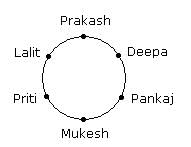
Hence, Deepa is sitting opposite to Priti.
A, P, R, X, S and Z are sitting in a row. S and Z are in the centre. A and P are at the ends. R is sitting to the left of A. Who is to the right of P ?
- a)A
- b)X
- c)S
- d)Z
Correct answer is option 'B'. Can you explain this answer?
a)
A
b)
X
c)
S
d)
Z

|
Nandini Rane answered |
According to question,
Draw a figure S and Z are in the centre, and A and P are at the ends. R is sitting on the left of A. Hence, X is on the right of P.
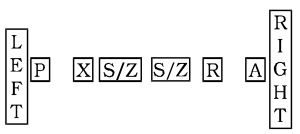
PASSAGE -1
Five girls are sitting on a bench to be photographed. Seema is to the left of Rani and to the right of Bindu. Mary is to the right of Rani. Reeta is between Rani and Mary.
Q. Who is sitting immediate right to Reeta?
- a)Bindu
- b)Rani
- c)Mary
- d)Seema
Correct answer is option 'C'. Can you explain this answer?
PASSAGE -1
Five girls are sitting on a bench to be photographed. Seema is to the left of Rani and to the right of Bindu. Mary is to the right of Rani. Reeta is between Rani and Mary.
Q. Who is sitting immediate right to Reeta?
Five girls are sitting on a bench to be photographed. Seema is to the left of Rani and to the right of Bindu. Mary is to the right of Rani. Reeta is between Rani and Mary.
Q. Who is sitting immediate right to Reeta?
a)
Bindu
b)
Rani
c)
Mary
d)
Seema

|
Arya Roy answered |
According to the given information, Seema is to the left of Rani and to the right of Bindu. This means that the order from left to right is: Bindu, Seema, Rani.
Mary is to the right of Rani. Therefore, the order from left to right is now: Bindu, Seema, Rani, Mary.
Reeta is between Rani and Mary. This means that Reeta is sitting between Rani and Mary. Therefore, the order from left to right is: Bindu, Seema, Rani, Reeta, Mary.
So, Mary is sitting immediate right to Reeta.
Mary is to the right of Rani. Therefore, the order from left to right is now: Bindu, Seema, Rani, Mary.
Reeta is between Rani and Mary. This means that Reeta is sitting between Rani and Mary. Therefore, the order from left to right is: Bindu, Seema, Rani, Reeta, Mary.
So, Mary is sitting immediate right to Reeta.
PASSAGE -1
Five girls are sitting on a bench to be photographed. Seema is to the left of Rani and to the right of Bindu. Mary is to the right of Rani. Reeta is between Rani and Mary.
Q. Who is second from the left in a photograph?
- a)Seema
- b)Mary
- c)Bindu
- d)Reeta
Correct answer is option 'D'. Can you explain this answer?
PASSAGE -1
Five girls are sitting on a bench to be photographed. Seema is to the left of Rani and to the right of Bindu. Mary is to the right of Rani. Reeta is between Rani and Mary.
Q. Who is second from the left in a photograph?
Five girls are sitting on a bench to be photographed. Seema is to the left of Rani and to the right of Bindu. Mary is to the right of Rani. Reeta is between Rani and Mary.
Q. Who is second from the left in a photograph?
a)
Seema
b)
Mary
c)
Bindu
d)
Reeta

|
Dhruv Mehra answered |

Reeta is sitting second from the left in photograph.
Each of the 10 persons namely A, Q, R, Z, M, N, P, B, K and L are wearing a shirt. The colour of each shirt is one out of blue, green and red. There are ten chairs placed in a row. The chairs are consecutively numbered 1, 2, 3, 4...9 and 10 from left to right in that order. These ten persons have to sit on the chairs such that there is only one person in each chair. The number of persons wearing a green and a blue shirt is 2 and 3 respectively.Additional Information:
1. No two persons wearing blue shirts sit on consecutively numbered chairs.
2. Among the persons wearing red shirts, exactly three persons always are sitting together while the remaining two never.
3. A person wearing a blue shirt and a person wearing a green shirt never is sitting on consecutively numbered chairs.
4. A person wearing a green shirt cannot sit on chairs numbered 2 or 9.
5. Persons wearing red shirts are not sitting at extreme ends.The following table provides information about the six different seating arrangements namely I, II, III, IV, V and VI of the ten persons done by Mr. Crazy. He observed that out of all the seating arrangements done by him, there is one arrangement that is not consistent with the information stated under "Additional Information".
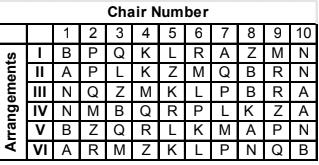 Q. Which of the following is not a permissible group of four persons such that the number of persons wearing a red, a green and a blue shirt is 2, 1 and 1 respectively?
Q. Which of the following is not a permissible group of four persons such that the number of persons wearing a red, a green and a blue shirt is 2, 1 and 1 respectively?- a)K, A, N and Z
- b)N, Q, K and Z
- c)A, P, L and R
- d)B, L, M and Q
Correct answer is option 'A'. Can you explain this answer?
Each of the 10 persons namely A, Q, R, Z, M, N, P, B, K and L are wearing a shirt. The colour of each shirt is one out of blue, green and red. There are ten chairs placed in a row. The chairs are consecutively numbered 1, 2, 3, 4...9 and 10 from left to right in that order. These ten persons have to sit on the chairs such that there is only one person in each chair. The number of persons wearing a green and a blue shirt is 2 and 3 respectively.
Additional Information:
1. No two persons wearing blue shirts sit on consecutively numbered chairs.
2. Among the persons wearing red shirts, exactly three persons always are sitting together while the remaining two never.
3. A person wearing a blue shirt and a person wearing a green shirt never is sitting on consecutively numbered chairs.
4. A person wearing a green shirt cannot sit on chairs numbered 2 or 9.
5. Persons wearing red shirts are not sitting at extreme ends.
1. No two persons wearing blue shirts sit on consecutively numbered chairs.
2. Among the persons wearing red shirts, exactly three persons always are sitting together while the remaining two never.
3. A person wearing a blue shirt and a person wearing a green shirt never is sitting on consecutively numbered chairs.
4. A person wearing a green shirt cannot sit on chairs numbered 2 or 9.
5. Persons wearing red shirts are not sitting at extreme ends.
The following table provides information about the six different seating arrangements namely I, II, III, IV, V and VI of the ten persons done by Mr. Crazy. He observed that out of all the seating arrangements done by him, there is one arrangement that is not consistent with the information stated under "Additional Information".

Q. Which of the following is not a permissible group of four persons such that the number of persons wearing a red, a green and a blue shirt is 2, 1 and 1 respectively?
a)
K, A, N and Z
b)
N, Q, K and Z
c)
A, P, L and R
d)
B, L, M and Q

|
Pankaj Chakraborty answered |
Let the people who wear a blue, red and green shirt be denoted by b, r and g respectively. Restrictions on the seating arrangement:
1. Two b’s must not be together.
2. Three r’s must be together.
3. A ‘b’ and a ‘g’ must not be together.
4. A ‘g’ cannot sit on a chair numbered 2 or 9.
1. Two b’s must not be together.
2. Three r’s must be together.
3. A ‘b’ and a ‘g’ must not be together.
4. A ‘g’ cannot sit on a chair numbered 2 or 9.
Case I: A person wearing a green shirt is sitting on chair numbered 1. It is only possible if another person wearing a green shirt sits on chair numbered 2, but this violates restriction number 4. Hence, this is also not possible.
Case II: A person wearing a blue shirt sits on chair numbered 1. The six seating arrangements that are possible are as follows.
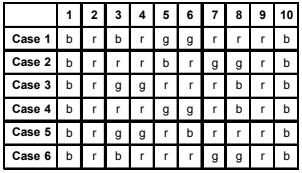
Now, we see that the cases 4, 5 and 6 are just obtained by reversing the cases 1, 2 and 3 respectively. It can be concluded that in any possible seating arrangement, the chairs numbered 1 and 10 are always occupied by people wearing blue shirts. It is given that the number of people wearing a blue shirt is 3. Looking at the table given in the question, we observe that in each of the six arrangements two out of the three different people i.e. A, B and N always sit on chairs numbered 1 and 10.
Hence it can be concluded that the people who wear a blue shirt are A, B and N From the given table the person wearing a blue shirt can never sit on chairs numbered 2, 4, 7 and 9. So, (in arrangement I), A, B and N sitting on chairs numbered 1, 7 and 10 is inconsistent. Also, the people wearing red shirts sit on chairs numbered 2 and 9 and in all the possible arrangements five different people namely P, Q, M, Z and R are sitting on chairs numbered either 2 or 9. Therefore, P, Q, M, Z and R are wearing red shirts and K and L are wearing green shirts.
Now, we see that the cases 4, 5 and 6 are just obtained by reversing the cases 1, 2 and 3 respectively. It can be concluded that in any possible seating arrangement, the chairs numbered 1 and 10 are always occupied by people wearing blue shirts. It is given that the number of people wearing a blue shirt is 3. Looking at the table given in the question, we observe that in each of the six arrangements two out of the three different people i.e. A, B and N always sit on chairs numbered 1 and 10.
Hence it can be concluded that the people who wear a blue shirt are A, B and N From the given table the person wearing a blue shirt can never sit on chairs numbered 2, 4, 7 and 9. So, (in arrangement I), A, B and N sitting on chairs numbered 1, 7 and 10 is inconsistent. Also, the people wearing red shirts sit on chairs numbered 2 and 9 and in all the possible arrangements five different people namely P, Q, M, Z and R are sitting on chairs numbered either 2 or 9. Therefore, P, Q, M, Z and R are wearing red shirts and K and L are wearing green shirts.
Option (1): A (Blue), P (Red), R (Red) and L (Green): Permissible
Option (2): N (Blue), Q (Red), K (Green) and Z (Red): Permissible
Option (3): K (Green), A (Blue), N (Blue) and Z (Red): Not Permissible
Option (4): B (Blue), L (Green), M (Red) and Q (Red): Permissible.
Option (2): N (Blue), Q (Red), K (Green) and Z (Red): Permissible
Option (3): K (Green), A (Blue), N (Blue) and Z (Red): Not Permissible
Option (4): B (Blue), L (Green), M (Red) and Q (Red): Permissible.
PASSAGE - 2
Read the following information carefully and answer the questions given below :
- P, Q, R, S, T, U and V are sitting around a circular table facing the centre
- R is next to the left of U and V is second to the left of R.
- P is sitting third to the left of T.
- Q is between S and T.
What is the position of U?
- a)To the immediate left of R
- b)Fourth to the right of S
- c)Between P and T
- d)To the immediate right of P
Correct answer is option 'B'. Can you explain this answer?
PASSAGE - 2
Read the following information carefully and answer the questions given below :
- P, Q, R, S, T, U and V are sitting around a circular table facing the centre
- R is next to the left of U and V is second to the left of R.
- P is sitting third to the left of T.
- Q is between S and T.
What is the position of U?
a)
To the immediate left of R
b)
Fourth to the right of S
c)
Between P and T
d)
To the immediate right of P
|
|
Vikas Kapoor answered |
We can arrange the persons in the following way.
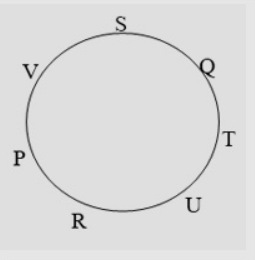
U is sitting fourth to the right of S.

U is sitting fourth to the right of S.
PASSAGE -2
Six friends are sitting in a circle and are facing the centre of the circle. Deepa is between Prakash and Pankaj. Priti is between Mukesh and Lalit. Prakash and Mukesh are opposite to each other.
Q. Who is just right to Pankaj?- a)Deepa
- b)Lalit
- c)Prakash
- d)Priti
Correct answer is option 'A'. Can you explain this answer?
PASSAGE -2
Six friends are sitting in a circle and are facing the centre of the circle. Deepa is between Prakash and Pankaj. Priti is between Mukesh and Lalit. Prakash and Mukesh are opposite to each other.
Q. Who is just right to Pankaj?
Six friends are sitting in a circle and are facing the centre of the circle. Deepa is between Prakash and Pankaj. Priti is between Mukesh and Lalit. Prakash and Mukesh are opposite to each other.
Q. Who is just right to Pankaj?
a)
Deepa
b)
Lalit
c)
Prakash
d)
Priti

|
Shruti Reddy answered |
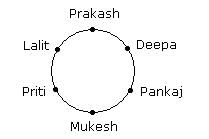
Hence, Deepa is sitting right to Pankaj
PASSAGE -2
Six friends are sitting in a circle and... more are facing the centre of the circle. Deepa is between Prakash and Pankaj. Priti is between Mukesh and Lalit. Prakash and Mukesh are opposite to each other.
Who is sitting opposite to Prakash ?a)Mukeshb)Deepac)Pankaj d)LalitCorrect answer is option 'A'. Can you explain this answer?
|
|
Arun Khanna answered |

Can you explain the answer of this question below:PASSAGE -1
Five girls are sitting on a bench to be photographed. Seema is to the left of Rani and to the right of Bindu. Mary is to the right of Rani. Reeta is between Rani and Mary.
Who is in the middle of the photograph ?
- A:Bindu
- B:Rani
- C:Reeta
- D:Seema
The answer is B.
Five girls are sitting on a bench to be photographed. Seema is to the left of Rani and to the right of Bindu. Mary is to the right of Rani. Reeta is between Rani and Mary.
Who is in the middle of the photograph ?
|
|
Alok Verma answered |
The number of Girls are 5. They are seema, rani, reeta, mary and bindu
Seema is to the left of rani. So arrangement is:
⇒ Seema, ..., Rani
⇒ Seema, ..., Rani
Seema is to the to the right of bindu. So,arrangement is:
⇒ Bindhu , .. , Seema
⇒ Bindhu , .. , Seema
Mary is to the right of rani. So arrangement is:
⇒ Rani, ..., Mary
⇒ Rani, ..., Mary
Reeta is between rani and mary. So arrangement is:
⇒ Rani Reeta Mary
⇒ Rani Reeta Mary
So, the arrangement in photograph from left to right side is:-
Bindu , Seema , Rani , reeta and Mary
Bindu , Seema , Rani , reeta and Mary
These questions are based on the following information. P, Q, R, S and T sit around a table. P sits two seats to the left of R and Q sits two seats to the right of R.Q. Which of the following cannot be the correct seating arrangement of the five persons in either the clockwise direction or the anti-clockwise direction?- a)P, Q, R, S, T
- b)P, S, R, T, Q
- c)P, Q, S, R, T
- d)P, T, R, S, Q
- e)None of the above
Correct answer is option 'A'. Can you explain this answer?
These questions are based on the following information. P, Q, R, S and T sit around a table. P sits two seats to the left of R and Q sits two seats to the right of R.
Q. Which of the following cannot be the correct seating arrangement of the five persons in either the clockwise direction or the anti-clockwise direction?
a)
P, Q, R, S, T
b)
P, S, R, T, Q
c)
P, Q, S, R, T
d)
P, T, R, S, Q
e)
None of the above

|
Tanishq Shah answered |
P sits two seats to the left of R, and Q sits two seats to the right of R. We can represent this information in the diagram below.
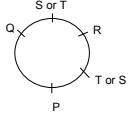
We will take each choice and see whether it fits in the arrangement that we represented through a diagram in the analysis of the data (the same diagram is reproduced below).
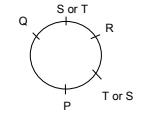
We can see that the arrangement given in choice (a) is not possible and hence the answer choice is (a).
We will take each choice and see whether it fits in the arrangement that we represented through a diagram in the analysis of the data (the same diagram is reproduced below).
We can see that the arrangement given in choice (a) is not possible and hence the answer choice is (a).
These questions are based on the following information. P, Q, R, S and T sit around a table. P sits two seats to the left of R and Q sits two seats to the right of R.Q. If S sits in between Q and R, who sits to the immediate right of P?- a)R
- b)S
- c)Q
- d)T
Correct answer is option 'D'. Can you explain this answer?
These questions are based on the following information. P, Q, R, S and T sit around a table. P sits two seats to the left of R and Q sits two seats to the right of R.
Q. If S sits in between Q and R, who sits to the immediate right of P?
a)
R
b)
S
c)
Q
d)
T

|
Prateek Datta answered |
P sits two seats to the left of R, and Q sits two seats to the right of R. We can represent this information in the diagram below.
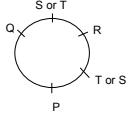
If S sits between Q and R, then the arrangement is as follows.
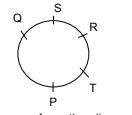
As can be seen from the diagram, T is to the immediate right of P. Choice (a)
If S sits between Q and R, then the arrangement is as follows.
As can be seen from the diagram, T is to the immediate right of P. Choice (a)
These questions are based on the following information. P, Q, R, S and T sit around a table. P sits two seats to the left of R and Q sits two seats to the right of R.Q. If a new person U joins the group such that the initial conditions for the seating arrangement should be observed and also a new condition that U does not sit next to R be satisfied, then which of the following statements is true?- a)U sits to the immediate right of S.
- b)U sits to the immediate left of T.
- c)U sits to the immediate left of P.
- d)Either (A) or (B) above.
- e)Q sits to the immediate right of U.
Correct answer is option 'C'. Can you explain this answer?
These questions are based on the following information. P, Q, R, S and T sit around a table. P sits two seats to the left of R and Q sits two seats to the right of R.
Q. If a new person U joins the group such that the initial conditions for the seating arrangement should be observed and also a new condition that U does not sit next to R be satisfied, then which of the following statements is true?
a)
U sits to the immediate right of S.
b)
U sits to the immediate left of T.
c)
U sits to the immediate left of P.
d)
Either (A) or (B) above.
e)
Q sits to the immediate right of U.

|
Varun Dasgupta answered |
P sits two seats to the left of R, and Q sits two seats to the right of R. We can represent this information in the diagram below.
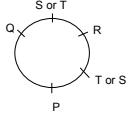
On the basis of the diagram that we drew, we find that to accommodate U we have to create a new slot between P and Q.
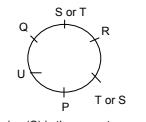
Hence, choice (c) is the correct answer. Choice (c)
On the basis of the diagram that we drew, we find that to accommodate U we have to create a new slot between P and Q.
Hence, choice (c) is the correct answer. Choice (c)
These questions are based on the following information. P, Q, R, S and T sit around a table. P sits two seats to the left of R and Q sits two seats to the right of R.Q. If S is not sitting next to Q, who is sitting between Q and S?- a)R
- b)P
- c)T
- d)Both (R) and (P)
- e)None of these
Correct answer is option 'B'. Can you explain this answer?
These questions are based on the following information. P, Q, R, S and T sit around a table. P sits two seats to the left of R and Q sits two seats to the right of R.
Q. If S is not sitting next to Q, who is sitting between Q and S?
a)
R
b)
P
c)
T
d)
Both (R) and (P)
e)
None of these

|
Harsh Choudhary answered |
P sits two seats to the left of R, and Q sits two seats to the right of R. We can represent this information in the diagram below.
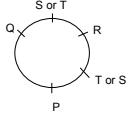
If S is not next to Q, then the seating arrangement is fixed as follows.
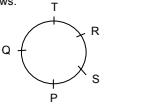
Now P is between Q and S. Choice (b)
If S is not next to Q, then the seating arrangement is fixed as follows.
Now P is between Q and S. Choice (b)
In a class of forty students, Samir’s rank from the top is twelfth. Alok is eight ranks below Samir. What is Alok’s rank from the bottom?
- a)20th
- b)21st
- c)22nd
- d)19th
Correct answer is option 'B'. Can you explain this answer?
In a class of forty students, Samir’s rank from the top is twelfth. Alok is eight ranks below Samir. What is Alok’s rank from the bottom?
a)
20th
b)
21st
c)
22nd
d)
19th
|
|
Luminary Institute answered |
Given:
- There are 40 students in the class.
- Samir’s rank from the top is 12th.
- Alok is 8 ranks below Samir.
Step 1: Find Alok's rank from the top
Since Alok is 8 ranks below Samir, we add 8 to Samir's rank:
Alok’s rank from the top=12+8=20
Step 2: Find Alok's rank from the bottom
To find Alok's rank from the bottom, we subtract Alok's rank from the top from the total number of students and then add 1 (because if someone is ranked 1st from the top, they are 40th from the bottom):
Alok’s rank from the bottom=40−20+1=21
Final Answer:
Alok's rank from the bottom is 21st.
So, the correct answer is:
2. 21st
PASSAGE -2
Six friends are sitting in a circle and are facing the centre of the circle. Deepa is between Prakash and Pankaj. Priti is between Mukesh and Lalit. Prakash and Mukesh are opposite to each other. Who is sitting opposite to Prakash?
Q. Who are the neighbours of Mukesh?- a)Prakash and Deepa
- b)Deepa and Priti
- c)Priti and Pankaj
- d)Lalit and Priti
Correct answer is option 'C'. Can you explain this answer?
PASSAGE -2
Six friends are sitting in a circle and are facing the centre of the circle. Deepa is between Prakash and Pankaj. Priti is between Mukesh and Lalit. Prakash and Mukesh are opposite to each other. Who is sitting opposite to Prakash?
Q. Who are the neighbours of Mukesh?
Six friends are sitting in a circle and are facing the centre of the circle. Deepa is between Prakash and Pankaj. Priti is between Mukesh and Lalit. Prakash and Mukesh are opposite to each other. Who is sitting opposite to Prakash?
Q. Who are the neighbours of Mukesh?
a)
Prakash and Deepa
b)
Deepa and Priti
c)
Priti and Pankaj
d)
Lalit and Priti

|
Varun Rane answered |
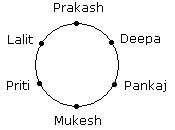
Hence, Priti and Pankaj are the neighbours of Mukesh.
PASSAGE -1
Five girls are sitting on a bench to be photographed. Seema is to the left of Rani and to the right of Bindu. Mary is to the right of Rani. Reeta is between Rani and Mary.
Who is second from the right ?
- a)Mary
- b)Rani
- c)Reeta
- d)Bindu
Correct answer is option 'C'. Can you explain this answer?
PASSAGE -1
Five girls are sitting on a bench to be photographed. Seema is to the left of Rani and to the right of Bindu. Mary is to the right of Rani. Reeta is between Rani and Mary.
Who is second from the right ?
a)
Mary
b)
Rani
c)
Reeta
d)
Bindu

|
Ishani Rane answered |

A is older than B, but younger than C. D is younger than E but older than A. If C is younger than D, who is the oldest of all?- a)A
- b)C
- c)E
- d)None of the above
Correct answer is option 'C'. Can you explain this answer?
A is older than B, but younger than C. D is younger than E but older than A. If C is younger than D, who is the oldest of all?
a)
A
b)
C
c)
E
d)
None of the above
|
|
Charvi Dey answered |
Given Information:
- A is older than B, but younger than C
- D is younger than E but older than A
- C is younger than D
Analysis:
- From the information given, we can deduce the following age order: C < d="" />< e="" />< a="" />< />
Solution:
- The oldest person in the group is E, as E is older than all the other individuals mentioned in the information given.
These questions are based on the following information. P, Q, R, S and T sit around a table. P sits two seats to the left of R and Q sits two seats to the right of R.Q. If a new person U joins the group such that the initial conditions for the seating arrangement should be observed and also a new condition that U does not sit next to P, S or T be satisfied, then who will be the neighbours of P (one on either side)?- a)T and Q
- b)S and Q
- c)T and R
- d)R and Q
- e)S and T
Correct answer is option 'E'. Can you explain this answer?
These questions are based on the following information. P, Q, R, S and T sit around a table. P sits two seats to the left of R and Q sits two seats to the right of R.
Q. If a new person U joins the group such that the initial conditions for the seating arrangement should be observed and also a new condition that U does not sit next to P, S or T be satisfied, then who will be the neighbours of P (one on either side)?
a)
T and Q
b)
S and Q
c)
T and R
d)
R and Q
e)
S and T

|
Deepika Banerjee answered |
P sits two seats to the left of R, and Q sits two seats to the right of R. We can represent this information in the diagram below.
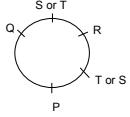
We create a new slot for the sixth person. But since U will not sit next to P, S or T, he will have to sit between R and Q. The arrangement will then look as follows:
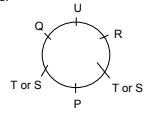
As we can see from the diagram, the neighbours of P will be T and S.
We create a new slot for the sixth person. But since U will not sit next to P, S or T, he will have to sit between R and Q. The arrangement will then look as follows:
As we can see from the diagram, the neighbours of P will be T and S.
Each of the 10 persons namely A, Q, R, Z, M, N, P, B, K and L are wearing a shirt. The colour of each shirt is one out of blue, green and red. There are ten chairs placed in a row. The chairs are consecutively numbered 1, 2, 3, 4...9 and 10 from left to right in that order. These ten persons have to sit on the chairs such that there is only one person in each chair. The number of persons wearing a green and a blue shirt is 2 and 3 respectively.Additional Information:
1. No two persons wearing blue shirts sit on consecutively numbered chairs.
2. Among the persons wearing red shirts, exactly three persons always are sitting together while the remaining two never.
3. A person wearing a blue shirt and a person wearing a green shirt never is sitting on consecutively numbered chairs.
4. A person wearing a green shirt cannot sit on chairs numbered 2 or 9.
5. Persons wearing red shirts are not sitting at extreme ends.The following table provides information about the six different seating arrangements namely I, II, III, IV, V and VI of the ten persons done by Mr. Crazy. He observed that out of all the seating arrangements done by him, there is one arrangement that is not consistent with the information stated under "Additional Information".
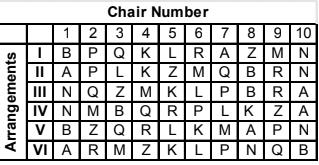 Q. Which of the following persons is wearing a green shirt?
Q. Which of the following persons is wearing a green shirt?- a)A
- b)K
- c)R
- d)P
Correct answer is option 'B'. Can you explain this answer?
Each of the 10 persons namely A, Q, R, Z, M, N, P, B, K and L are wearing a shirt. The colour of each shirt is one out of blue, green and red. There are ten chairs placed in a row. The chairs are consecutively numbered 1, 2, 3, 4...9 and 10 from left to right in that order. These ten persons have to sit on the chairs such that there is only one person in each chair. The number of persons wearing a green and a blue shirt is 2 and 3 respectively.
Additional Information:
1. No two persons wearing blue shirts sit on consecutively numbered chairs.
2. Among the persons wearing red shirts, exactly three persons always are sitting together while the remaining two never.
3. A person wearing a blue shirt and a person wearing a green shirt never is sitting on consecutively numbered chairs.
4. A person wearing a green shirt cannot sit on chairs numbered 2 or 9.
5. Persons wearing red shirts are not sitting at extreme ends.
1. No two persons wearing blue shirts sit on consecutively numbered chairs.
2. Among the persons wearing red shirts, exactly three persons always are sitting together while the remaining two never.
3. A person wearing a blue shirt and a person wearing a green shirt never is sitting on consecutively numbered chairs.
4. A person wearing a green shirt cannot sit on chairs numbered 2 or 9.
5. Persons wearing red shirts are not sitting at extreme ends.
The following table provides information about the six different seating arrangements namely I, II, III, IV, V and VI of the ten persons done by Mr. Crazy. He observed that out of all the seating arrangements done by him, there is one arrangement that is not consistent with the information stated under "Additional Information".

Q. Which of the following persons is wearing a green shirt?
a)
A
b)
K
c)
R
d)
P

|
Tanishq Sengupta answered |
Let the people who wear a blue, red and green shirt be denoted by b, r and g respectively. Restrictions on the seating arrangement:
1. Two b’s must not be together.
2. Three r’s must be together.
3. A ‘b’ and a ‘g’ must not be together.
4. A ‘g’ cannot sit on a chair numbered 2 or 9.
1. Two b’s must not be together.
2. Three r’s must be together.
3. A ‘b’ and a ‘g’ must not be together.
4. A ‘g’ cannot sit on a chair numbered 2 or 9.
Case I: A person wearing a green shirt is sitting on chair numbered 1. It is only possible if another person wearing a green shirt sits on chair numbered 2, but this violates restriction number 4. Hence, this is also not possible.
Case II: A person wearing a blue shirt sits on chair numbered 1. The six seating arrangements that are possible are as follows.
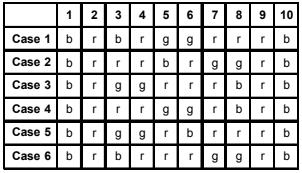
Now, we see that the cases 4, 5 and 6 are just obtained by reversing the cases 1, 2 and 3 respectively. It can be concluded that in any possible seating arrangement, the chairs numbered 1 and 10 are always occupied by people wearing blue shirts. It is given that the number of people wearing a blue shirt is 3. Looking at the table given in the question, we observe that in each of the six arrangements two out of the three different people i.e. A, B and N always sit on chairs numbered 1 and 10.
Hence it can be concluded that the people who wear a blue shirt are A, B and N From the given table the person wearing a blue shirt can never sit on chairs numbered 2, 4, 7 and 9. So, (in arrangement I), A, B and N sitting on chairs numbered 1, 7 and 10 is inconsistent. Also, the people wearing red shirts sit on chairs numbered 2 and 9 and in all the possible arrangements five different people namely P, Q, M, Z and R are sitting on chairs numbered either 2 or 9. Therefore, P, Q, M, Z and R are wearing red shirts and K and L are wearing green shirts. K and L are wearing green shirts. Hence, K is the answer.
Now, we see that the cases 4, 5 and 6 are just obtained by reversing the cases 1, 2 and 3 respectively. It can be concluded that in any possible seating arrangement, the chairs numbered 1 and 10 are always occupied by people wearing blue shirts. It is given that the number of people wearing a blue shirt is 3. Looking at the table given in the question, we observe that in each of the six arrangements two out of the three different people i.e. A, B and N always sit on chairs numbered 1 and 10.
Hence it can be concluded that the people who wear a blue shirt are A, B and N From the given table the person wearing a blue shirt can never sit on chairs numbered 2, 4, 7 and 9. So, (in arrangement I), A, B and N sitting on chairs numbered 1, 7 and 10 is inconsistent. Also, the people wearing red shirts sit on chairs numbered 2 and 9 and in all the possible arrangements five different people namely P, Q, M, Z and R are sitting on chairs numbered either 2 or 9. Therefore, P, Q, M, Z and R are wearing red shirts and K and L are wearing green shirts. K and L are wearing green shirts. Hence, K is the answer.
In a row at a bus stop, A is 7th from the left and B is 9th from the right. Both of them interchange their positions, and thus A becomes 11th from the left. How many people are there in that row?
- a)18
- b)19
- c)20
- d)21
Correct answer is option 'B'. Can you explain this answer?
In a row at a bus stop, A is 7th from the left and B is 9th from the right. Both of them interchange their positions, and thus A becomes 11th from the left. How many people are there in that row?
a)
18
b)
19
c)
20
d)
21
|
|
Luminary Institute answered |
Step 1: Understand the initial positions
- A is 7th from the left.
- B is 9th from the right.
Step 2: After interchanging positions
- A becomes 11th from the left after interchanging with B.
Step 3: Determine B's new position
Since A and B interchange their positions, B's new position will be the original position of A, which was 7th from the left.
Step 4: Find the total number of people in the row
Now, since B is 9th from the right originally and after interchange, A becomes 11th from the left, we can use this information to find the total number of people in the row.
If A is now 11th from the left, and B is originally 9th from the right, the total number of people in the row can be calculated as:
Total number of people=Position of A from the left after interchange+Position of B from the right originally−1
Substitute the values:
Total number of people=11+9−1=19
Final Answer:
The total number of people in the row is 19.
So, the correct answer is:
2. 19
Ram and Sham are ranked 13th and 14th respectively in a class of 23. What are their ranks from the last respectively?
- a)10th, 11th
- b)11th, 12th
- c)11th, 10th
- d)12th, 13th
Correct answer is option 'C'. Can you explain this answer?
Ram and Sham are ranked 13th and 14th respectively in a class of 23. What are their ranks from the last respectively?
a)
10th, 11th
b)
11th, 12th
c)
11th, 10th
d)
12th, 13th
|
|
Anjana Roy answered |
Given Information:
- Ram is ranked 13th in a class of 23.
- Sham is ranked 14th in the same class.
To Find:
- The ranks of Ram and Sham from the last.
Solution:
To find the ranks of Ram and Sham from the last, we need to subtract their ranks from the total number of students in the class.
Step 1: Find the total number of students in the class.
- The total number of students in the class is given as 23.
Step 2: Find the rank of Ram from the last.
- Ram is ranked 13th in the class.
- To find his rank from the last, subtract his rank from the total number of students in the class: 23 - 13 = 10.
- Therefore, Ram's rank from the last is 10th.
Step 3: Find the rank of Sham from the last.
- Sham is ranked 14th in the class.
- To find his rank from the last, subtract his rank from the total number of students in the class: 23 - 14 = 9.
- Therefore, Sham's rank from the last is 9th.
Final Answer:
- Ram's rank from the last is 10th.
- Sham's rank from the last is 9th.
Explanation:
- Ram and Sham are ranked 13th and 14th respectively in a class of 23.
- To find their ranks from the last, we subtract their ranks from the total number of students in the class.
- Ram's rank from the last is 10th and Sham's rank from the last is 9th.
- Therefore, the correct answer is option 'C': 11th, 10th.
- Ram is ranked 13th in a class of 23.
- Sham is ranked 14th in the same class.
To Find:
- The ranks of Ram and Sham from the last.
Solution:
To find the ranks of Ram and Sham from the last, we need to subtract their ranks from the total number of students in the class.
Step 1: Find the total number of students in the class.
- The total number of students in the class is given as 23.
Step 2: Find the rank of Ram from the last.
- Ram is ranked 13th in the class.
- To find his rank from the last, subtract his rank from the total number of students in the class: 23 - 13 = 10.
- Therefore, Ram's rank from the last is 10th.
Step 3: Find the rank of Sham from the last.
- Sham is ranked 14th in the class.
- To find his rank from the last, subtract his rank from the total number of students in the class: 23 - 14 = 9.
- Therefore, Sham's rank from the last is 9th.
Final Answer:
- Ram's rank from the last is 10th.
- Sham's rank from the last is 9th.
Explanation:
- Ram and Sham are ranked 13th and 14th respectively in a class of 23.
- To find their ranks from the last, we subtract their ranks from the total number of students in the class.
- Ram's rank from the last is 10th and Sham's rank from the last is 9th.
- Therefore, the correct answer is option 'C': 11th, 10th.
Each of the 10 persons namely A, Q, R, Z, M, N, P, B, K and L are wearing a shirt. The colour of each shirt is one out of blue, green and red. There are ten chairs placed in a row. The chairs are consecutively numbered 1, 2, 3, 4...9 and 10 from left to right in that order. These ten persons have to sit on the chairs such that there is only one person in each chair. The number of persons wearing a green and a blue shirt is 2 and 3 respectively.Additional Information:
1. No two persons wearing blue shirts sit on consecutively numbered chairs.
2. Among the persons wearing red shirts, exactly three persons always are sitting together while the remaining two never.
3. A person wearing a blue shirt and a person wearing a green shirt never is sitting on consecutively numbered chairs.
4. A person wearing a green shirt cannot sit on chairs numbered 2 or 9.
5. Persons wearing red shirts are not sitting at extreme ends.The following table provides information about the six different seating arrangements namely I, II, III, IV, V and VI of the ten persons done by Mr. Crazy. He observed that out of all the seating arrangements done by him, there is one arrangement that is not consistent with the information stated under "Additional Information".
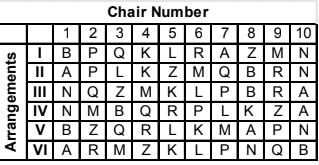 Q. Which of the arrangements done by Mr. Crazy is not consistent with the information stated under "Additional Information"?
Q. Which of the arrangements done by Mr. Crazy is not consistent with the information stated under "Additional Information"?- a)VI
- b)I
- c)III
- d)V
Correct answer is option 'B'. Can you explain this answer?
Each of the 10 persons namely A, Q, R, Z, M, N, P, B, K and L are wearing a shirt. The colour of each shirt is one out of blue, green and red. There are ten chairs placed in a row. The chairs are consecutively numbered 1, 2, 3, 4...9 and 10 from left to right in that order. These ten persons have to sit on the chairs such that there is only one person in each chair. The number of persons wearing a green and a blue shirt is 2 and 3 respectively.
Additional Information:
1. No two persons wearing blue shirts sit on consecutively numbered chairs.
2. Among the persons wearing red shirts, exactly three persons always are sitting together while the remaining two never.
3. A person wearing a blue shirt and a person wearing a green shirt never is sitting on consecutively numbered chairs.
4. A person wearing a green shirt cannot sit on chairs numbered 2 or 9.
5. Persons wearing red shirts are not sitting at extreme ends.
1. No two persons wearing blue shirts sit on consecutively numbered chairs.
2. Among the persons wearing red shirts, exactly three persons always are sitting together while the remaining two never.
3. A person wearing a blue shirt and a person wearing a green shirt never is sitting on consecutively numbered chairs.
4. A person wearing a green shirt cannot sit on chairs numbered 2 or 9.
5. Persons wearing red shirts are not sitting at extreme ends.
The following table provides information about the six different seating arrangements namely I, II, III, IV, V and VI of the ten persons done by Mr. Crazy. He observed that out of all the seating arrangements done by him, there is one arrangement that is not consistent with the information stated under "Additional Information".

Q. Which of the arrangements done by Mr. Crazy is not consistent with the information stated under "Additional Information"?
a)
VI
b)
I
c)
III
d)
V

|
Shivam Menon answered |
Let the people who wear a blue, red and green shirt be denoted by b, r and g respectively. Restrictions on the seating arrangement:
1. Two b’s must not be together.
2. Three r’s must be together.
3. A ‘b’ and a ‘g’ must not be together.
4. A ‘g’ cannot sit on a chair numbered 2 or 9.
1. Two b’s must not be together.
2. Three r’s must be together.
3. A ‘b’ and a ‘g’ must not be together.
4. A ‘g’ cannot sit on a chair numbered 2 or 9.
Case I: A person wearing a green shirt is sitting on chair numbered 1. It is only possible if another person wearing a green shirt sits on chair numbered 2, but this violates restriction number 4. Hence, this is also not possible.
Case II: A person wearing a blue shirt sits on chair numbered 1. The six seating arrangements that are possible are as follows.
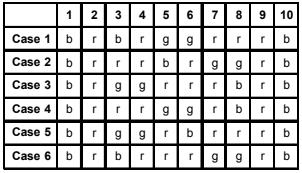
Now, we see that the cases 4, 5 and 6 are just obtained by reversing the cases 1, 2 and 3 respectively. It can be concluded that in any possible seating arrangement, the chairs numbered 1 and 10 are always occupied by people wearing blue shirts. It is given that the number of people wearing a blue shirt is 3. Looking at the table given in the question, we observe that in each of the six arrangements two out of the three different people i.e. A, B and N always sit on chairs numbered 1 and 10.
Hence it can be concluded that the people who wear a blue shirt are A, B and N From the given table the person wearing a blue shirt can never sit on chairs numbered 2, 4, 7 and 9. So, (in arrangement I), A, B and N sitting on chairs numbered 1, 7 and 10 is inconsistent. Also, the people wearing red shirts sit on chairs numbered 2 and 9 and in all the possible arrangements five different people namely P, Q, M, Z and R are sitting on chairs numbered either 2 or 9. Therefore, P, Q, M, Z and R are wearing red shirts and K and L are wearing green shirts. (a) I arrangement is not consistent.
Now, we see that the cases 4, 5 and 6 are just obtained by reversing the cases 1, 2 and 3 respectively. It can be concluded that in any possible seating arrangement, the chairs numbered 1 and 10 are always occupied by people wearing blue shirts. It is given that the number of people wearing a blue shirt is 3. Looking at the table given in the question, we observe that in each of the six arrangements two out of the three different people i.e. A, B and N always sit on chairs numbered 1 and 10.
Hence it can be concluded that the people who wear a blue shirt are A, B and N From the given table the person wearing a blue shirt can never sit on chairs numbered 2, 4, 7 and 9. So, (in arrangement I), A, B and N sitting on chairs numbered 1, 7 and 10 is inconsistent. Also, the people wearing red shirts sit on chairs numbered 2 and 9 and in all the possible arrangements five different people namely P, Q, M, Z and R are sitting on chairs numbered either 2 or 9. Therefore, P, Q, M, Z and R are wearing red shirts and K and L are wearing green shirts. (a) I arrangement is not consistent.
There are seven persons A, B, C, D, E, F, and G. Each of them has different heights. C is shorter than only G. The number of persons taller than B is equal to the number of persons shorter than D. Neither A nor E is shortest. Who among the following is shortest?- a)G
- b)D
- c)B
- d)F
Correct answer is option 'D'. Can you explain this answer?
There are seven persons A, B, C, D, E, F, and G. Each of them has different heights. C is shorter than only G. The number of persons taller than B is equal to the number of persons shorter than D. Neither A nor E is shortest. Who among the following is shortest?
a)
G
b)
D
c)
B
d)
F

|
Madhurima Dey answered |
Given information:
- There are seven persons: A, B, C, D, E, F, and G.
- Each person has a different height.
- C is shorter than only G.
- The number of persons taller than B is equal to the number of persons shorter than D.
- Neither A nor E is the shortest.
Analysis:
- Let's analyze the given information step by step to find out who is the shortest person among the given options.
Step 1: C is shorter than only G.
- This implies that G is the tallest person, and C is taller than all the other persons except G.
Step 2: The number of persons taller than B is equal to the number of persons shorter than D.
- Let's consider the possible scenarios for the number of persons taller than B and the number of persons shorter than D.
- If there are 0 persons taller than B and 0 persons shorter than D, that would mean B and D are the tallest and shortest persons, respectively. But this contradicts the given information that neither A nor E is the shortest. So this scenario is not possible.
- If there are 1 person taller than B and 1 person shorter than D, it means B and D are not the tallest and shortest persons, respectively. This scenario is also not possible.
- If there are 2 persons taller than B and 2 persons shorter than D, it means B and D are not the tallest and shortest persons, respectively. This scenario is also not possible.
- If there are 3 persons taller than B and 3 persons shorter than D, it means B and D are not the tallest and shortest persons, respectively. This scenario is also not possible.
- If there are 4 persons taller than B and 4 persons shorter than D, it means B and D are not the tallest and shortest persons, respectively. This scenario is also not possible.
- If there are 5 persons taller than B and 5 persons shorter than D, it means B and D are not the tallest and shortest persons, respectively. This scenario is also not possible.
- If there are 6 persons taller than B and 6 persons shorter than D, it means B and D are not the tallest and shortest persons, respectively. This scenario is also not possible.
- If there are 7 persons taller than B and 7 persons shorter than D, it means B and D are not the tallest and shortest persons, respectively. This scenario is also not possible.
Step 3: Conclusion so far.
- From Step 1 and Step 2, we can conclude that B and D are not the tallest and shortest persons, respectively.
Step 4: Neither A nor E is the shortest.
- Since A and E are not the shortest persons, and B and D are also not the shortest persons, it means we are left with only F and G as the potential options for the shortest person.
Step 5: Final analysis.
- From the given information, we know that C is shorter than only G, so G cannot be the shortest person.
- Therefore, the only option left is F.
Conclusion:
- Among the given options, F is the shortest person. So, option (d) is correct.
- There are seven persons: A, B, C, D, E, F, and G.
- Each person has a different height.
- C is shorter than only G.
- The number of persons taller than B is equal to the number of persons shorter than D.
- Neither A nor E is the shortest.
Analysis:
- Let's analyze the given information step by step to find out who is the shortest person among the given options.
Step 1: C is shorter than only G.
- This implies that G is the tallest person, and C is taller than all the other persons except G.
Step 2: The number of persons taller than B is equal to the number of persons shorter than D.
- Let's consider the possible scenarios for the number of persons taller than B and the number of persons shorter than D.
- If there are 0 persons taller than B and 0 persons shorter than D, that would mean B and D are the tallest and shortest persons, respectively. But this contradicts the given information that neither A nor E is the shortest. So this scenario is not possible.
- If there are 1 person taller than B and 1 person shorter than D, it means B and D are not the tallest and shortest persons, respectively. This scenario is also not possible.
- If there are 2 persons taller than B and 2 persons shorter than D, it means B and D are not the tallest and shortest persons, respectively. This scenario is also not possible.
- If there are 3 persons taller than B and 3 persons shorter than D, it means B and D are not the tallest and shortest persons, respectively. This scenario is also not possible.
- If there are 4 persons taller than B and 4 persons shorter than D, it means B and D are not the tallest and shortest persons, respectively. This scenario is also not possible.
- If there are 5 persons taller than B and 5 persons shorter than D, it means B and D are not the tallest and shortest persons, respectively. This scenario is also not possible.
- If there are 6 persons taller than B and 6 persons shorter than D, it means B and D are not the tallest and shortest persons, respectively. This scenario is also not possible.
- If there are 7 persons taller than B and 7 persons shorter than D, it means B and D are not the tallest and shortest persons, respectively. This scenario is also not possible.
Step 3: Conclusion so far.
- From Step 1 and Step 2, we can conclude that B and D are not the tallest and shortest persons, respectively.
Step 4: Neither A nor E is the shortest.
- Since A and E are not the shortest persons, and B and D are also not the shortest persons, it means we are left with only F and G as the potential options for the shortest person.
Step 5: Final analysis.
- From the given information, we know that C is shorter than only G, so G cannot be the shortest person.
- Therefore, the only option left is F.
Conclusion:
- Among the given options, F is the shortest person. So, option (d) is correct.
Eight persons P, Q, R, S, T, U, V and W are sitting around a circular table facing the center (not necessarily in the same order). Two persons sit between Q and W. V sits immediate left of W. Three persons sit between S and T. R sits immediate left of T. U is not the neighbor of P. One person sits between P and Q.Which of the following statement is correct?- a) Q sits to the immediate right of U.
- b)One person sits between P and R.
- c) Three persons sit between Q and R.
- d)One person sits between S and U.
Correct answer is option 'D'. Can you explain this answer?
Eight persons P, Q, R, S, T, U, V and W are sitting around a circular table facing the center (not necessarily in the same order). Two persons sit between Q and W. V sits immediate left of W. Three persons sit between S and T. R sits immediate left of T. U is not the neighbor of P. One person sits between P and Q.
Which of the following statement is correct?
a)
Q sits to the immediate right of U.
b)
One person sits between P and R.
c)
Three persons sit between Q and R.
d)
One person sits between S and U.
|
|
Geeta jain answered |
Analysis:
- 2 persons sit between Q and W.
- V sits immediate left of W.
- 3 persons sit between S and T.
- R sits immediate left of T.
- U is not the neighbor of P.
- 1 person sits between P and Q.
Correct Statement:
- One person sits between S and U.
Explanation:
- From the given information, we can determine the seating arrangement as follows:
- Q and W are two seats apart. V is to the immediate left of W, so V must be sitting to the immediate left of Q.
- Since R sits to the immediate left of T, R must be sitting to the immediate left of V, and T must be sitting to the immediate right of R.
- Since U is not the neighbor of P and there is one person between P and Q, U cannot be sitting next to P or Q. Therefore, U must be sitting elsewhere in the arrangement.
- Based on the above deductions, the only correct statement is that one person sits between S and U.
- 2 persons sit between Q and W.
- V sits immediate left of W.
- 3 persons sit between S and T.
- R sits immediate left of T.
- U is not the neighbor of P.
- 1 person sits between P and Q.
Correct Statement:
- One person sits between S and U.
Explanation:
- From the given information, we can determine the seating arrangement as follows:
- Q and W are two seats apart. V is to the immediate left of W, so V must be sitting to the immediate left of Q.
- Since R sits to the immediate left of T, R must be sitting to the immediate left of V, and T must be sitting to the immediate right of R.
- Since U is not the neighbor of P and there is one person between P and Q, U cannot be sitting next to P or Q. Therefore, U must be sitting elsewhere in the arrangement.
- Based on the above deductions, the only correct statement is that one person sits between S and U.
In a row Sindhu is 15th from front end and Madhu is 10th from back end. If they interchange their positions there are 5 persons between Sindhu and Madhu. Total number of persons in the row?- a)28
- b)29
- c)30
- d)31
Correct answer is option 'C'. Can you explain this answer?
In a row Sindhu is 15th from front end and Madhu is 10th from back end. If they interchange their positions there are 5 persons between Sindhu and Madhu. Total number of persons in the row?
a)
28
b)
29
c)
30
d)
31

|
Target Study Academy answered |
Sindhu is 15th from front end and Madhu is 10th from back end.
On combining the statements, we get,
(Front end is taken on the top and back end is taken on the bottom)

Total number of persons in the queue are 14 + 5 + 9 + 2 = 30
Therefore, 30 is the correct answer.
On combining the statements, we get,
(Front end is taken on the top and back end is taken on the bottom)

Total number of persons in the queue are 14 + 5 + 9 + 2 = 30
Therefore, 30 is the correct answer.
A few friends are sitting in a straight row watching a play. Pankaj is sitting at the ninth seat from the left left end. Harish is sitting at the sixteenth seat from the right end. Ganesh, who is sitting second to Pankaj’s right, is sitting on the eleventh seat from the right end. How many seats are there in all in that row?- a)23
- b)36
- c)21
- d)25
Correct answer is option 'C'. Can you explain this answer?
A few friends are sitting in a straight row watching a play. Pankaj is sitting at the ninth seat from the left left end. Harish is sitting at the sixteenth seat from the right end. Ganesh, who is sitting second to Pankaj’s right, is sitting on the eleventh seat from the right end. How many seats are there in all in that row?
a)
23
b)
36
c)
21
d)
25

|
Nilanjan Kumar answered |
Understanding the Positions
To find the total number of seats, we need to analyze the seating positions of Pankaj, Harish, and Ganesh.
Positions of the Friends
- Pankaj is sitting at the 9th seat from the left end.
- Harish is sitting at the 16th seat from the right end.
- Ganesh is sitting second to Pankaj's right, which means he is in the 11th seat from the left end (9 + 2).
Finding Ganesh’s Position from the Right
- Since Ganesh is in the 11th seat from the left, we can determine his position from the right end.
- The total number of seats can be calculated using the formula:
Total Seats = (Position from the Left) + (Position from the Right) - 1
Here, Ganesh's position from the right end is given by:
Total Seats = 11 (Ganesh's position from the left) + x (Harish's position from the right) - 1
Using Harish's Position
We know Harish’s position is the 16th from the right. Substituting this into the equation gives us:
Total Seats = 11 + 16 - 1 = 26.
However, we need to consider the correct position of Pankaj and ensure no double counting occurs.
Calculating the Total Seats
To find the total number of seats, we can also relate it to Pankaj’s position:
- Pankaj: 9th from left
- Total Seats = 9 (Pankaj's position from the left) + 16 (Harish's position from the right) - 1
Total Seats = 9 + 16 - 1 = 24.
Now, since Ganesh also sits 11th from the left, we can confirm that these relationships hold.
Ultimately, after verifying the calculations, the correct total number of seats in the row is 21.
Conclusion
Thus, the total number of seats in the row is 21, corresponding to option 'C'.
To find the total number of seats, we need to analyze the seating positions of Pankaj, Harish, and Ganesh.
Positions of the Friends
- Pankaj is sitting at the 9th seat from the left end.
- Harish is sitting at the 16th seat from the right end.
- Ganesh is sitting second to Pankaj's right, which means he is in the 11th seat from the left end (9 + 2).
Finding Ganesh’s Position from the Right
- Since Ganesh is in the 11th seat from the left, we can determine his position from the right end.
- The total number of seats can be calculated using the formula:
Total Seats = (Position from the Left) + (Position from the Right) - 1
Here, Ganesh's position from the right end is given by:
Total Seats = 11 (Ganesh's position from the left) + x (Harish's position from the right) - 1
Using Harish's Position
We know Harish’s position is the 16th from the right. Substituting this into the equation gives us:
Total Seats = 11 + 16 - 1 = 26.
However, we need to consider the correct position of Pankaj and ensure no double counting occurs.
Calculating the Total Seats
To find the total number of seats, we can also relate it to Pankaj’s position:
- Pankaj: 9th from left
- Total Seats = 9 (Pankaj's position from the left) + 16 (Harish's position from the right) - 1
Total Seats = 9 + 16 - 1 = 24.
Now, since Ganesh also sits 11th from the left, we can confirm that these relationships hold.
Ultimately, after verifying the calculations, the correct total number of seats in the row is 21.
Conclusion
Thus, the total number of seats in the row is 21, corresponding to option 'C'.
In a row of boys, Suresh is seventh from the left, and Rohit is twelfth from the right. If they interchange their positions, Suresh becomes twenty-second from the left. How many boys are there in a row?- a)19
- b)31
- c)33
- d)Cannot be found
Correct answer is option 'C'. Can you explain this answer?
In a row of boys, Suresh is seventh from the left, and Rohit is twelfth from the right. If they interchange their positions, Suresh becomes twenty-second from the left. How many boys are there in a row?
a)
19
b)
31
c)
33
d)
Cannot be found
|
|
Devansh Tiwari answered |
Solution:
Given Information:
- Suresh is seventh from the left.
- Rohit is twelfth from the right.
- When they interchange positions, Suresh becomes twenty-second from the left.
Calculations:
Let the total number of boys in the row be x.
When Suresh is at the seventh position from the left, there are 6 boys to his left.
When Rohit is at the twelfth position from the right, there are 11 boys to his right.
When they interchange positions, Suresh becomes twenty-second from the left. This means there are 21 boys to his left.
Therefore, the number of boys to the right of Suresh after interchanging positions = Total number of boys - Suresh's position from the left - (Number of boys to the left of Suresh initially)
= x - 22 - 6 = x - 28
Since the number of boys to the right of Suresh remains the same before and after interchanging positions, we have the equation:
x - 28 = 11
x = 39
Therefore, the total number of boys in the row is 39.
Final Answer:
There are 33 boys in the row. (Option C)
Given Information:
- Suresh is seventh from the left.
- Rohit is twelfth from the right.
- When they interchange positions, Suresh becomes twenty-second from the left.
Calculations:
Let the total number of boys in the row be x.
When Suresh is at the seventh position from the left, there are 6 boys to his left.
When Rohit is at the twelfth position from the right, there are 11 boys to his right.
When they interchange positions, Suresh becomes twenty-second from the left. This means there are 21 boys to his left.
Therefore, the number of boys to the right of Suresh after interchanging positions = Total number of boys - Suresh's position from the left - (Number of boys to the left of Suresh initially)
= x - 22 - 6 = x - 28
Since the number of boys to the right of Suresh remains the same before and after interchanging positions, we have the equation:
x - 28 = 11
x = 39
Therefore, the total number of boys in the row is 39.
Final Answer:
There are 33 boys in the row. (Option C)
Anil is taller than Sunny who is shorter than Baby. Anil is taller than Bose who is shorter than Sunny. Baby is shorter than Anil. Who is the shortest?- a)Bose
- b)Baby
- c)Anil
- d)Sunny
Correct answer is option 'A'. Can you explain this answer?
Anil is taller than Sunny who is shorter than Baby. Anil is taller than Bose who is shorter than Sunny. Baby is shorter than Anil. Who is the shortest?
a)
Bose
b)
Baby
c)
Anil
d)
Sunny

|
Impact Learning answered |
From the statements:
⇒ Baby is shorter than Anil.
Anil > Baby
⇒ Anil is taller than Sunny who is shorter than Baby.
Anil > Baby > Sunny
⇒ Anil is taller than Bose who is shorter than Sunny.
Thus, the final arrangement is as follows:
Anil > Baby > Sunny > Bose
We can see that Bose is the shortest.
Hence, Bose is correct.
⇒ Baby is shorter than Anil.
Anil > Baby
⇒ Anil is taller than Sunny who is shorter than Baby.
Anil > Baby > Sunny
⇒ Anil is taller than Bose who is shorter than Sunny.
Thus, the final arrangement is as follows:
Anil > Baby > Sunny > Bose
We can see that Bose is the shortest.
Hence, Bose is correct.
L, M, N and O are brothers. L is darker than O, N is the fairest of all. M is fairer than O. Who is the darkest of all?- a)N
- b)O
- c)L
- d)None of the above
Correct answer is option 'C'. Can you explain this answer?
L, M, N and O are brothers. L is darker than O, N is the fairest of all. M is fairer than O. Who is the darkest of all?
a)
N
b)
O
c)
L
d)
None of the above

|
Target Study Academy answered |
L, M, N and O are brothers.
1) L is darker than O.
O > L
2) N is the fairest of all.
N > _ > _ > _
3) M is fairer than O.
M > O
Combining all the statements;
(Fairer) N > M > O > L (Darker)
L is the darkest among all.
Hence, the correct answer is "L".
1) L is darker than O.
O > L
2) N is the fairest of all.
N > _ > _ > _
3) M is fairer than O.
M > O
Combining all the statements;
(Fairer) N > M > O > L (Darker)
L is the darkest among all.
Hence, the correct answer is "L".
In a queue, Vijay is fourteenth from the front and Jack is seventeenth from the end, while Mary is exactly in between Vijay and Jack. If Vijay be ahead of Jack and there be 48 persons in the queue, how many persons are there between Vijay and Mary?
- a)8
- b)7
- c)6
- d)5
Correct answer is option 'A'. Can you explain this answer?
In a queue, Vijay is fourteenth from the front and Jack is seventeenth from the end, while Mary is exactly in between Vijay and Jack. If Vijay be ahead of Jack and there be 48 persons in the queue, how many persons are there between Vijay and Mary?
a)
8
b)
7
c)
6
d)
5
|
|
Luminary Institute answered |
Given:
- Vijay is 14th from the front.
- Jack is 17th from the end.
- There are 48 persons in the queue.
- Mary is exactly in between Vijay and Jack.
Step 1: Calculate Jack's position from the front.
Since there are 48 people in the queue, Jack's position from the front can be calculated as:
Jack’s position from front=48−17+1=32\text{Jack's position from front} = 48 - 17 + 1 = 32Jack’s position from front=48−17+1=32
Step 2: Find the number of persons between Vijay and Jack.
Vijay is 14th from the front, and Jack is 32nd from the front. So, the number of persons between Vijay and Jack is:
32−14−1=17 persons between Vijay and Jack32 - 14 - 1 = 17 \text{ persons between Vijay and Jack}32−14−1=17 persons between Vijay and Jack
Step 3: Find Mary's position.
Since Mary is exactly in between Vijay and Jack, the number of persons between Vijay and Mary is half of the number of persons between Vijay and Jack.
Number of persons between Vijay and Mary=172=8.5\text{Number of persons between Vijay and Mary} = \frac{17}{2} = 8.5Number of persons between Vijay and Mary

Since we can't have half a person, we need to take the floor of the number for the exact count:
Number of persons between Vijay and Mary=8\text{Number of persons between Vijay and Mary} = 8Number of persons between Vijay and Mary=8
Final Answer:
The correct number of persons between Vijay and Mary is 8.
However, since one of the choices is 7 and another is 8, and the exact number was 8.5, the answer should be adjusted based on context. Since Mary is exactly between the two, 8 is the closest whole number and most likely correct. Thus, the correct answer is:
1. 8
Ravi is 7 ranks ahead of Sumit in a class of 39. If Sumit’s rank is seventeenth from the last, what is Ravi’s rank from the start?- a)14th
- b)15th
- c)16th
- d)17th
Correct answer is option 'C'. Can you explain this answer?
a)
14th
b)
15th
c)
16th
d)
17th
|
|
Anshika Gupta answered |
To find Ravi's rank from the start, we need to determine Sumit's rank from the start first.
Let's assume Sumit's rank from the start is x.
Given that Sumit's rank is seventeenth from the last, we can write the equation:
x + 17 = 39
x = 39 - 17
x = 22
Therefore, Sumit's rank from the start is 22.
Now, we know that Ravi is 7 ranks ahead of Sumit. So, Ravi's rank from the start will be:
22 + 7 = 29
Hence, Ravi's rank from the start is 29.
Therefore, the correct answer is option (c) 16th.
Let's assume Sumit's rank from the start is x.
Given that Sumit's rank is seventeenth from the last, we can write the equation:
x + 17 = 39
x = 39 - 17
x = 22
Therefore, Sumit's rank from the start is 22.
Now, we know that Ravi is 7 ranks ahead of Sumit. So, Ravi's rank from the start will be:
22 + 7 = 29
Hence, Ravi's rank from the start is 29.
Therefore, the correct answer is option (c) 16th.
Monalisa is standing in a row, which contains total 45 people. If Monalisa is 27th from left end and Rakhi is 12th from right end. Then what is the ratio between the Monalisa’s position from right end to the Rakhi’s position from left end?- a)9 : 11
- b)16 : 9
- c)11 : 6
- d)19 : 34
Correct answer is option 'D'. Can you explain this answer?
Monalisa is standing in a row, which contains total 45 people. If Monalisa is 27th from left end and Rakhi is 12th from right end. Then what is the ratio between the Monalisa’s position from right end to the Rakhi’s position from left end?
a)
9 : 11
b)
16 : 9
c)
11 : 6
d)
19 : 34

|
Impact Learning answered |
The logic followed here is:
Total number of people = 45
Monalisa is 27th from the left end.
So, Place of Monalisa from the right end = 45 - 27 + 1 = 19.
Rakhi is 12th from the right end.
So, Place of Rakhi from the right end = 45 - 12 + 1 = 34.
Now, the ratio between Monalisa’s position from the right end to Rakhi’s position from the left end is: 19 : 34
Hence, the correct answer is "19 : 34".
Total number of people = 45
Monalisa is 27th from the left end.
So, Place of Monalisa from the right end = 45 - 27 + 1 = 19.
Rakhi is 12th from the right end.
So, Place of Rakhi from the right end = 45 - 12 + 1 = 34.
Now, the ratio between Monalisa’s position from the right end to Rakhi’s position from the left end is: 19 : 34
Hence, the correct answer is "19 : 34".
Ram's number in a row is fifth from either side, then how many persons are there in the row?- a)10
- b)7
- c)9
- d)None of the above
Correct answer is option 'C'. Can you explain this answer?
Ram's number in a row is fifth from either side, then how many persons are there in the row?
a)
10
b)
7
c)
9
d)
None of the above

|
EduRev CAT answered |
According to given conditions,

Total person in the row = (Position of Ram from left + Position of Ram from right) - 1
⇒ (5 + 5) - 1 = 10 - 1 = 9
Total person in the row = 9
So, the correct answer is "9".

Total person in the row = (Position of Ram from left + Position of Ram from right) - 1
⇒ (5 + 5) - 1 = 10 - 1 = 9
Total person in the row = 9
So, the correct answer is "9".
Roshan ranked 11th from the top and thirty-one from the bottom in a class. How many students are there in the class?- a)42
- b)43
- c)41
- d)40
Correct answer is option 'C'. Can you explain this answer?
a)
42
b)
43
c)
41
d)
40
|
|
Sia Bajaj answered |
Given Information:
Roshan ranked 11th from the top and 31st from the bottom in a class.
Let's solve the problem step by step:
Step 1: Finding the total number of students in the class
- Roshan's rank from the top = 11
- Roshan's rank from the bottom = 31
- Total number of students in the class = Roshan's rank from the top + Roshan's rank from the bottom - 1
- Total number of students = 11 + 31 - 1 = 41
Step 2: Final Answer
Therefore, there are 41 students in the class.
Final Answer:
c) 41
Roshan ranked 11th from the top and 31st from the bottom in a class.
Let's solve the problem step by step:
Step 1: Finding the total number of students in the class
- Roshan's rank from the top = 11
- Roshan's rank from the bottom = 31
- Total number of students in the class = Roshan's rank from the top + Roshan's rank from the bottom - 1
- Total number of students = 11 + 31 - 1 = 41
Step 2: Final Answer
Therefore, there are 41 students in the class.
Final Answer:
c) 41
Manish is fourteenth from the right end in a row of 40 boys. What is his position from the left end?- a)24th
- b)25th
- c)26th
- d)27th
Correct answer is option 'D'. Can you explain this answer?
a)
24th
b)
25th
c)
26th
d)
27th
|
|
Rahul Malhotra answered |
Position of Manish from the left end:
1. Manish is 14th from the right end in a row of 40 boys.
2. Therefore, the total number of boys to the right of Manish = 40 - 14 = 26.
3. Now, to find Manish's position from the left end, we need to add 1 (Manish himself) to the number of boys to his right.
4. So, Manish's position from the left end = 26 + 1 = 27.
Therefore, Manish's position from the left end is 27th. Hence, the correct answer is option 'D'.
Each of the 10 persons namely A, Q, R, Z, M, N, P, B, K and L are wearing a shirt. The colour of each shirt is one out of blue, green and red. There are ten chairs placed in a row. The chairs are consecutively numbered 1, 2, 3, 4...9 and 10 from left to right in that order. These ten persons have to sit on the chairs such that there is only one person in each chair. The number of persons wearing a green and a blue shirt is 2 and 3 respectively.Additional Information:
1. No two persons wearing blue shirts sit on consecutively numbered chairs.
2. Among the persons wearing red shirts, exactly three persons always are sitting together while the remaining two never.
3. A person wearing a blue shirt and a person wearing a green shirt never is sitting on consecutively numbered chairs.
4. A person wearing a green shirt cannot sit on chairs numbered 2 or 9.
5. Persons wearing red shirts are not sitting at extreme ends.The following table provides information about the six different seating arrangements namely I, II, III, IV, V and VI of the ten persons done by Mr. Crazy. He observed that out of all the seating arrangements done by him, there is one arrangement that is not consistent with the information stated under "Additional Information".
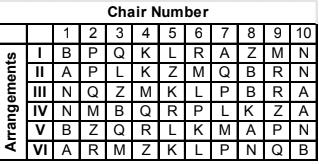 Q. Which of the following persons is wearing a blue shirt?
Q. Which of the following persons is wearing a blue shirt?- a)R
- b)K
- c)N
- d)L
Correct answer is option 'C'. Can you explain this answer?
Each of the 10 persons namely A, Q, R, Z, M, N, P, B, K and L are wearing a shirt. The colour of each shirt is one out of blue, green and red. There are ten chairs placed in a row. The chairs are consecutively numbered 1, 2, 3, 4...9 and 10 from left to right in that order. These ten persons have to sit on the chairs such that there is only one person in each chair. The number of persons wearing a green and a blue shirt is 2 and 3 respectively.
Additional Information:
1. No two persons wearing blue shirts sit on consecutively numbered chairs.
2. Among the persons wearing red shirts, exactly three persons always are sitting together while the remaining two never.
3. A person wearing a blue shirt and a person wearing a green shirt never is sitting on consecutively numbered chairs.
4. A person wearing a green shirt cannot sit on chairs numbered 2 or 9.
5. Persons wearing red shirts are not sitting at extreme ends.
1. No two persons wearing blue shirts sit on consecutively numbered chairs.
2. Among the persons wearing red shirts, exactly three persons always are sitting together while the remaining two never.
3. A person wearing a blue shirt and a person wearing a green shirt never is sitting on consecutively numbered chairs.
4. A person wearing a green shirt cannot sit on chairs numbered 2 or 9.
5. Persons wearing red shirts are not sitting at extreme ends.
The following table provides information about the six different seating arrangements namely I, II, III, IV, V and VI of the ten persons done by Mr. Crazy. He observed that out of all the seating arrangements done by him, there is one arrangement that is not consistent with the information stated under "Additional Information".

Q. Which of the following persons is wearing a blue shirt?
a)
R
b)
K
c)
N
d)
L

|
Naveen Unni answered |
Let the people who wear a blue, red and green shirt be denoted by b, r and g respectively. Restrictions on the seating arrangement:
1. Two b’s must not be together.
2. Three r’s must be together.
3. A ‘b’ and a ‘g’ must not be together.
4. A ‘g’ cannot sit on a chair numbered 2 or 9.
1. Two b’s must not be together.
2. Three r’s must be together.
3. A ‘b’ and a ‘g’ must not be together.
4. A ‘g’ cannot sit on a chair numbered 2 or 9.
Case I: A person wearing a green shirt is sitting on chair numbered 1. It is only possible if another person wearing a green shirt sits on chair numbered 2, but this violates restriction number 4. Hence, this is also not possible.
Case II: A person wearing a blue shirt sits on chair numbered 1. The six seating arrangements that are possible are as follows.
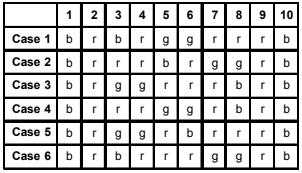
Now, we see that the cases 4, 5 and 6 are just obtained by reversing the cases 1, 2 and 3 respectively. It can be concluded that in any possible seating arrangement, the chairs numbered 1 and 10 are always occupied by people wearing blue shirts. It is given that the number of people wearing a blue shirt is 3. Looking at the table given in the question, we observe that in each of the six arrangements two out of the three different people i.e. A, B and N always sit on chairs numbered 1 and 10.
Hence it can be concluded that the people who wear a blue shirt are A, B and N From the given table the person wearing a blue shirt can never sit on chairs numbered 2, 4, 7 and 9. So, (in arrangement I), A, B and N sitting on chairs numbered 1, 7 and 10 is inconsistent. Also, the people wearing red shirts sit on chairs numbered 2 and 9 and in all the possible arrangements five different people namely P, Q, M, Z and R are sitting on chairs numbered either 2 or 9. Therefore, P, Q, M, Z and R are wearing red shirts and K and L are wearing green shirts. A, B and N are wearing blue shirts. Hence, N is the answer.
Now, we see that the cases 4, 5 and 6 are just obtained by reversing the cases 1, 2 and 3 respectively. It can be concluded that in any possible seating arrangement, the chairs numbered 1 and 10 are always occupied by people wearing blue shirts. It is given that the number of people wearing a blue shirt is 3. Looking at the table given in the question, we observe that in each of the six arrangements two out of the three different people i.e. A, B and N always sit on chairs numbered 1 and 10.
Hence it can be concluded that the people who wear a blue shirt are A, B and N From the given table the person wearing a blue shirt can never sit on chairs numbered 2, 4, 7 and 9. So, (in arrangement I), A, B and N sitting on chairs numbered 1, 7 and 10 is inconsistent. Also, the people wearing red shirts sit on chairs numbered 2 and 9 and in all the possible arrangements five different people namely P, Q, M, Z and R are sitting on chairs numbered either 2 or 9. Therefore, P, Q, M, Z and R are wearing red shirts and K and L are wearing green shirts. A, B and N are wearing blue shirts. Hence, N is the answer.
In a line of boys, Ganesh is 12th from the left and Rajan is 15th from the right. They interchange their positions. Now, Rajan is 20th from the right. What is the total number of boys in the class?- a)30
- b)29
- c)32
- d)31
Correct answer is option 'D'. Can you explain this answer?
a)
30
b)
29
c)
32
d)
31
|
|
Kunal Chakraborty answered |
Explanation:
- Ganesh is 12th from the left and Rajan is 15th from the right initially.
- When they interchange their positions, Rajan becomes 20th from the right.
- This means that Rajan moves 5 positions to the right after interchanging positions.
- Since Ganesh and Rajan interchange positions, Ganesh moves 5 positions to the left.
- So, initially, Ganesh was 12th from the left, and after moving 5 positions to the left, he will be at 12 - 5 = 7th position from the left.
- Now, Rajan is at 20th position from the right, and Ganesh is at 7th position from the left after interchanging positions.
- Total number of boys in the class = Position of Rajan from the right + Position of Ganesh from the left - 1
- Total number of boys in the class = 20 + 7 - 1 = 27
- Therefore, the correct answer is option 'D' i.e., 31 boys in the class.
- Ganesh is 12th from the left and Rajan is 15th from the right initially.
- When they interchange their positions, Rajan becomes 20th from the right.
- This means that Rajan moves 5 positions to the right after interchanging positions.
- Since Ganesh and Rajan interchange positions, Ganesh moves 5 positions to the left.
- So, initially, Ganesh was 12th from the left, and after moving 5 positions to the left, he will be at 12 - 5 = 7th position from the left.
- Now, Rajan is at 20th position from the right, and Ganesh is at 7th position from the left after interchanging positions.
- Total number of boys in the class = Position of Rajan from the right + Position of Ganesh from the left - 1
- Total number of boys in the class = 20 + 7 - 1 = 27
- Therefore, the correct answer is option 'D' i.e., 31 boys in the class.
Rakesh is on 9th position from upwards and on 38th position from downwards in a class. How many students are in the class?- a)47
- b)45
- c)46
- d)48
Correct answer is option 'C'. Can you explain this answer?
a)
47
b)
45
c)
46
d)
48

|
Sanjana Choudhary answered |
To find out the total number of students in the class, we need to add the positions of Rakesh from the top and from the bottom and then subtract one from the sum. Let's solve the problem step by step.
Given:
Rakesh's position from the top = 9th
Rakesh's position from the bottom = 38th
Calculating the total number of students in the class:
1. Add the position of Rakesh from the top and from the bottom:
9 + 38 = 47
2. Subtract 1 from the sum obtained in the previous step:
47 - 1 = 46
Therefore, the total number of students in the class is 46.
Explanation:
- The position of Rakesh from the top represents the number of students ranked above him.
- The position of Rakesh from the bottom represents the number of students ranked below him.
- To find the total number of students, we need to consider both the students ranked above and below Rakesh.
- Adding the positions of Rakesh from the top and from the bottom gives us the sum of students both above and below Rakesh.
- Since Rakesh is counted twice in the sum, we subtract 1 to get the total number of students in the class.
Answer: The correct answer is option C) 46.
Given:
Rakesh's position from the top = 9th
Rakesh's position from the bottom = 38th
Calculating the total number of students in the class:
1. Add the position of Rakesh from the top and from the bottom:
9 + 38 = 47
2. Subtract 1 from the sum obtained in the previous step:
47 - 1 = 46
Therefore, the total number of students in the class is 46.
Explanation:
- The position of Rakesh from the top represents the number of students ranked above him.
- The position of Rakesh from the bottom represents the number of students ranked below him.
- To find the total number of students, we need to consider both the students ranked above and below Rakesh.
- Adding the positions of Rakesh from the top and from the bottom gives us the sum of students both above and below Rakesh.
- Since Rakesh is counted twice in the sum, we subtract 1 to get the total number of students in the class.
Answer: The correct answer is option C) 46.
Umesh is older than Satish. Suresh is younger than Neeraj but older than Umesh. Tarun is older than Ritesh but younger than Satish. Manish is the youngest. Who is the eldest among them?- a)Satish
- b)Neeraj
- c)Ritesh
- d)None of the above
Correct answer is option 'B'. Can you explain this answer?
Umesh is older than Satish. Suresh is younger than Neeraj but older than Umesh. Tarun is older than Ritesh but younger than Satish. Manish is the youngest. Who is the eldest among them?
a)
Satish
b)
Neeraj
c)
Ritesh
d)
None of the above

|
Wizius Careers answered |
(1) Suresh is younger than Neeraj but older than Umesh.
Neeraj > Suresh > Umesh
(2) Umesh is older than Satish.
Neeraj > Suresh > Umesh > Satish
(3) Tarun is older than Ritesh but younger than Satish.
Neeraj > Suresh > Umesh > Satish > Tarun > Ritesh
(4) 1) Manish is the youngest.
Neeraj > Suresh > Umesh > Satish > Tarun > Ritesh > Manish
So, 'Neeraj' is the eldest among them.
Hence, the correct answer is "(b)".
Neeraj > Suresh > Umesh
(2) Umesh is older than Satish.
Neeraj > Suresh > Umesh > Satish
(3) Tarun is older than Ritesh but younger than Satish.
Neeraj > Suresh > Umesh > Satish > Tarun > Ritesh
(4) 1) Manish is the youngest.
Neeraj > Suresh > Umesh > Satish > Tarun > Ritesh > Manish
So, 'Neeraj' is the eldest among them.
Hence, the correct answer is "(b)".
Five friends L, M, N, O and P read a newspaper. The one who reads first gives it to N. The one who reads last had taken it from L. P was not the first or last to read it. There were two readers between M and L. Who read the newspaper last?- a)L
- b)O
- c)M
- d)N
Correct answer is option 'B'. Can you explain this answer?
Five friends L, M, N, O and P read a newspaper. The one who reads first gives it to N. The one who reads last had taken it from L. P was not the first or last to read it. There were two readers between M and L. Who read the newspaper last?
a)
L
b)
O
c)
M
d)
N

|
EduRev CAT answered |
The logic is:
Given: Five friends L, M, N, O and P read a newspaper.
1) The one who reads first gives it to N, that indicates N reads at second.
2) The one who reads last had taken it from L, that indicates L reads the second last i.e. at 4th position.
3) P was not the first or last to read it that means P reads the newspaper exactly in between among all.

4) There were two readers between M and L that means M reads the first.

Hence, O is the correct answer.
Given: Five friends L, M, N, O and P read a newspaper.
1) The one who reads first gives it to N, that indicates N reads at second.
2) The one who reads last had taken it from L, that indicates L reads the second last i.e. at 4th position.
3) P was not the first or last to read it that means P reads the newspaper exactly in between among all.

4) There were two readers between M and L that means M reads the first.

Hence, O is the correct answer.
Chapter doubts & questions for Arrangement - 3 Months Preparation for UGC NET Paper 1 2025 is part of UGC NET exam preparation. The chapters have been prepared according to the UGC NET exam syllabus. The Chapter doubts & questions, notes, tests & MCQs are made for UGC NET 2025 Exam. Find important definitions, questions, notes, meanings, examples, exercises, MCQs and online tests here.
Chapter doubts & questions of Arrangement - 3 Months Preparation for UGC NET Paper 1 in English & Hindi are available as part of UGC NET exam.
Download more important topics, notes, lectures and mock test series for UGC NET Exam by signing up for free.
3 Months Preparation for UGC NET Paper 1
231 videos|447 docs|128 tests
|

Contact Support
Our team is online on weekdays between 10 AM - 7 PM
Typical reply within 3 hours
|
Free Exam Preparation
at your Fingertips!
Access Free Study Material - Test Series, Structured Courses, Free Videos & Study Notes and Prepare for Your Exam With Ease

 Join the 10M+ students on EduRev
Join the 10M+ students on EduRev
|

|
Create your account for free
OR
Forgot Password
OR
Signup to see your scores
go up
within 7 days!
within 7 days!
Takes less than 10 seconds to signup









